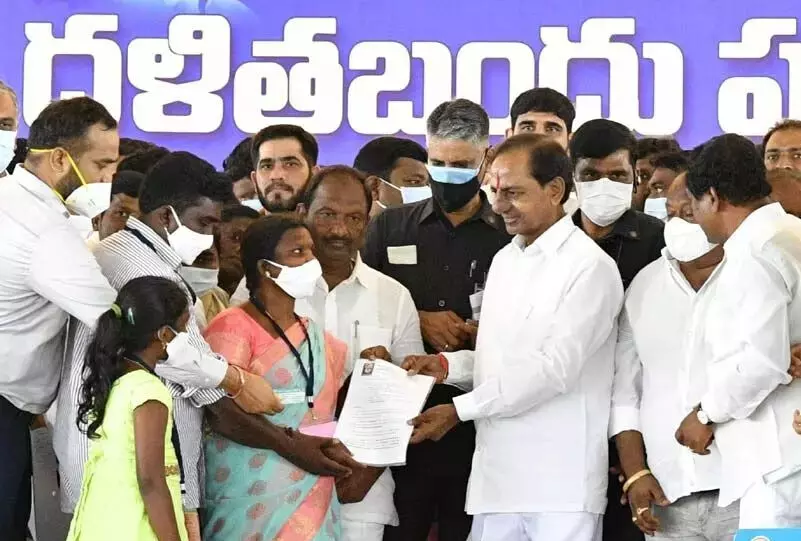10 Years of Telangana: Dalit Bandhu, country’s biggest DBT, reflects KCR’s holistic welfare vision
Like Rythu Bandhu and Rythu Bima, equally awe-inspiring and thought-provoking for the rest of the country was Dalit Bandhu, another jewel in KCR’s basket of welfare schemes

HYDERABAD: If ‘iconoclastic warrior’ is the best description of K Chandrashekar Rao’s leadership to the separate statehood movement, ‘all-encompassing welfare’ will be its ideal foil, epitomising the contrast in his nine-year rule in Telangana. Many of the schemes that oozed from the BRS chief’s vision are as much pathbreaking as they were exemplary in their success.
The behemoth of Kaleshwaram on one side redefined the world view on large-scale lift irrigation and left heavy engineering experts in awe for its sheer scale and the risks involved. On the flipside, it also showcased the raw courage of KCR to dare to dream, design and execute a complex project of this ilk that most people around the world would even shudder to think.
Talk of his Rythu Bandhu and Rythu Bima.., the reassuring ‘KCR twins’ brought smiles of contentment on the faces of Telangana peasants at a time when their ‘not-so-privileged’ brethren were braving police batons and bullets on the streets of the country’s capital in their crusade against the anti-farmer plans of the Narendra Modi government.
In a nutshell, the diminutive leader first broke a seven-decade-old glass ceiling to ‘carve out’ a long-cherished separate Telangana identity. Then, as the chief minister of Telangana, he busted all the traditional myths, broke barriers and threw stereotypes out of the window in his governance with unparalleled benchmarks.
Dalit Bandhu
Like Rythu Bandhu and Rythu Bima, equally awe-inspiring and thought-provoking for the rest of the country was Dalit Bandhu, another jewel in KCR’s basket of welfare schemes. Every initiative KCR devised for the benefit of his populace was elephantine in nature. And Dalit Bandhu too was no exception. Envisioned as a unique model for empowering Dalit families, the scheme till this moment remains as the biggest direct benefit transfer scheme in the country.
By KCR’s own assertion, anywhere between Rs 80,000 crores and Rs 1 lakh crores is the astronomical chunk from the state’s exchequer that his government is ready to spend for the novel scheme.
The state government launched Dalit Bandhu as a pilot project in Huzurabad Assembly constituency on August 16, 2021 before it was expanded across Telangana by the turn of 2022. Taking up the mantle to uplift the social and economic dignity of the SCs and end generations of discrimination against them, the BRS (then TRS) government introduced the Dalit Bandhu scheme which received overwhelming success. In short, it’s benevolence in the form of a free grant and reflects the State government’s social responsibility.
The scheme provides for Rs 10 lakh to eligible Dalit families and with no strings attached. The beneficiaries will receive the assistance, free from the hassles of bank linkage or security. And there is this rejoicing twist in the tale for the Dalits – No beneficiary needs to pay it back..! As part of the larger goal, the scheme, besides making Dalits self-sufficient, also has the potential to transform them into future entrepreneurs.
In yet another nation’s first, Dalit Bandhu is the only scheme in the country that is being implemented with 100 percent subsidy.
BC welfare – Rs 1 lakh to families of vocational communities
The KCR government has only recently issued a Government Order, granting Rs 1 lakh to the families of artisans belonging to the vocational communities. The State government’s decision was based on the recommendations to this effect of a cabinet sub-committee. The grant is seen as a big boon for BC and OBC beneficiaries in procuring the tools and paraphernalia used in their vocational professions.
Incidentally, the scheme will be kickstarted by KCR himself in Mancherial on Friday, June 9, 2023.
Here are some conditions laid out for eligibility to the most attractive scheme targeting artisans of vocational communities. Financial assistance of Rs 1 lakh will be provided to each beneficiary to enable them to excel in their chosen profession. And the scheme is applicable for only one person in a family. As on June 2, 2023, people in the age group of 18-55 years are eligible. The annual income of the beneficiary should not exceed Rs 1.5 lakhs in villages and Rs 2 lakhs in towns. Beneficiaries who have already received Rs.50 thousand and above through other government welfare schemes in the last five years are not eligible to apply for this scheme.
Incentives for inter-caste marriage couples
To move towards social Integration and usher in a casteless and classless society, incentives are being offered to couples who opt for Inter-caste marriages. Under this scheme, a cash incentive of Rs 10,000, along with an appreciation letter, is given to such couples with the rider that one of the spouses or both shall belong to Backward Classes.
Assistance to handloom weavers
The KCR government has also initiated a host of welfare programmes for the handloom workers of the state, as part of which, a digital handloom survey was conducted across the state and 21,750 handloom workers and 43,162 powerloom workers were identified. Geotagging numbers were given to them so that the incentives and schemes provided by the government could directly benefit the real handloom workers.
Chenetha Mitra (Input Subsidy Linked Wage Compensation Scheme)
The State Government is implementing a 40 percent subsidy on yarn, dyes and chemicals in addition to 10 percent subsidy from the Centre to all weavers and ancillary workers including those outside the cooperative fold as well as those in the cooperative fold. Incidentally, a scheme of this nature is implemented nowhere else in the country. Out of 40 percent subsidy, only 5 percent goes to the yarn purchaser and remaining 35 percent is transferred to the bank accounts of the weavers and ancillary workers on prorata basis of their wages earned. Because of this initiative, there is a 30 percent increase in their wages.
Till date, an amount of Rs 23.2 crores subsidy has been released directly into the bank accounts of (20,501) beneficiaries in the state.
Loan waiver scheme
The Telangana Government has issued orders for waiver of the individual working capital loans taken by handloom weavers for handloom weaving activity from nationalised banks and DCCBs for the period from 01.04.2010 to 31.03.2017 up to Rs 1 lakh and also above Rs 1 lakh (subject to the maximum ceiling of Rs 1 lakh only) including the closed loans.
The scheme for waiver of loans of individual weavers is intended to bring them out of the clutches of microfinance companies and money lenders and to relieve them from indebtedness so as to enable them to obtain fresh working capital from banks to eke out their livelihood.
Re-launch of Nethannaku Cheyutha scheme
Further, the Government has given approval for continuation of the scheme for the next three years with a budget requirement of Rs 90 crores. The government has given continuation for three years and a budget of Rs 60 crores has been released under the scheme for two years. The Scheme is being implemented since October 2021.
So far, an amount of Rs 88.30 crores have been released under the Scheme.
Nethanna Bima
The KCR government has launched Nethanna Bima (Life Insurance for Weavers) in Telangana on the lines of Rythu Bima scheme for weavers from August 14, 2022 to cover 55,072 handloom and power loom weavers and ancillary workers under LIC of India Insurance Scheme. Weavers in the age group of 18 to 59 years will be covered in the scheme. The family of a weaver or ancillary worker will receive an insured amount of Rs 5 lakh in the event of death. So far, 79 death claims have been settled and Rs 3.95 Crores have been credited to the nominees’ bank accounts.



